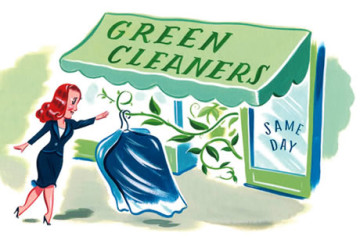Maintain a wardrobe without dry cleaning chemicals
For the average white-collar worker, getting your clothes dry-cleaned over the weekend is the first step towards preparing for the coming week. Apart from the fact that it eases you of dirty laundry, there are clothes that are so delicate that they cannot withstand the squeezing that hand-washing entails; just as there are fabrics that can’t withstand the rough and tumble of a washing machine and clothes dryer.
Again, there are clothes that come with manufacturer’s specific instruction to ‘dry clean only.’
The idea of a good Saturday morning does not include the one spent in the bathroom doing endless laundry. So, on the surface of it, dry cleaning saves you time and it also eliminates the intensive labour that goes with hand-washing.
Generally, when dry-cleaning a cloth, the dry cleaner uses chemical solvents other than water. Insiders say they use either tricholoroethylene (TCE, for short) or tetrachloroethylene (also known as perchloroethylene, PCE, or Perc, for short).
Dry cleaners swear that these solvents have excellent cleaning power and are stable, non-flammable, and gentle to most garments. However, environmentalists say the chemicals are so powerful that, if the dry cleaner forgets to check the clothes for foreign objects such as plastic pens in the pocket, the items will dissolve in the solvent bath and may damage fabrics beyond recovery.
An apprentice dry cleaner with a high-end dry cleaning outfit in Ikeja, Lagos, who refuses to be named, discloses that when treating prized fabrics belonging to influential customers, decorations such as appliqués or certain types of buttons are sometimes removed and reattached by a professional worker hired for that purpose.
He says that in other instances, such decorations may be shielded with a small padded protector so that the solvent doesn’t wreak havoc on them.
According to him, during dry cleaning process, all garments are immersed in the cleaning fluid and then cleaned in a liquid solvent. “We don’t use water, and that is why the process is called dry cleaning,” he explains.
He also says Perc is very effective for cleaning oil-based and red wine stains from delicate materials.
Before now, many health-conscious people had their misgivings about dry-cleaned clothes, but they had not been able to lay their hands on it. A group of scientists with the Danish Cancer Society Research Centre seem to have finally pulled the sheet on this washing method, though; albeit with unpalatable discoveries.
The researchers suggest that exposure to TCE may increase your chances of getting cancer.
Before this new study, scientists had also nailed its twin solvent, tetrachloroethylene, which is said to be carcinogenic to animals, affects fertility and causes hormonal disruption. Indeed, a United States Department of Human and Health Services Report on Carcinogens speculates that Perc may also cause cancer in humans.
The lead Danish study author, Dr. Johnni Hansen, says, “To determine TCE’s effect on humans, researchers followed more than 40,000 people between 1947 and 1989, monitoring their TCE levels and any incidences of cancer.
“During that time, we noticed that men who had been exposed to TCE were eight per cent more likely to get cancer, while women were 23 per cent more likely to get the disease.”
Worse still, TCE is also used in much larger quantities as a degreaser in the metal industry, and experts warn that those exposed to it risk getting cancer. And, as fearful as it sounds, it’s not only users of dry-cleaned clothes that are exposed to the effects of the chemicals, workers and those who reside close to dry cleaning plants also inhale the fumes that attend dry cleaning activities.
Of utmost concern, researchers say, is the likely pollution that ground (well or bore hole) water might also be exposed to as the solvents seep into the soil or broken pipes. This has impact on those who drink such ground water.
Again, researchers at Georgetown University declare that Perc is retained in dry-cleaned clothes and that its levels increase with repeat cleaning. In a study published in online journal, Environmental Toxicology & Chemistry, the researchers warn, “(Perc) chemical residue was highest in wool, cotton and polyester that had been dry cleaned; but absent from silk.”
So, what is it to these solvents that buyers should beware of? For one, scientists say PCE and TCE are contaminants, and when used on clothes, they inevitably come into contact with the wearer’s skin, and are also released into the air inside homes and automobiles.
The Georgetown Prof. Paul Roepe, who supervised the study, notes, “Human PCE exposure has been linked to elevated risk of cancer by the Environmental Protection Agency, which has labelled PCE a likely carcinogen.”
The researchers express concern that PCE can be absorbed through inhalation, mouth or skin contact.
“It is slowly emitted from dry-cleaned fabrics, even when wrapped in dry plastic wrap. In a warm, closed environment such as inside a car or a closet, the chemicals could be expelled at an even greater rate,” the study’s authors warn.
While the scientists confess that they don’t have the complete answers to the quantities of solvents that could be inhaled or absorbed through the skin to cause enough damage to health, Roepe says, “I think we know enough to suggest that more studies should be done very quickly.”
Again, Perc is also suspected of being toxic to the brain and the nervous system. In order to be sure of its suspicion, EPA detailed the National Academy of Sciences to reexamine the toxicity of Perc, and the NAS returned a verdict of “quite dangerous,” confirming EPA’s fears.
The problem with Perc use has assumed a serious dimension in some states in the United States. For instance, California has banned its use in residential buildings, while it has also passed a law that will outlaw it in the state by the year 2023.
Finally, EPA has this to say about Perc, “The extent of any health effects from Perc exposure depends on the amount of Perc and how long the exposure lasts. People exposed to high levels of Perc, even for brief periods, may experience serious symptoms such as dizziness, fatigue, headaches, confusion, nausea; and skin, lung, eye and mucous membrane irritation.
“Repeated exposure to high levels can also irritate the skin, eyes, nose and mouth, and can cause liver damage and respiratory failure.”
EPA says further, “Studies in laboratory animals indicate that exposures to high levels of Perc can produce effects on the developing foetus that include altered growth, birth defects, and death.
“There is also evidence, from several studies of workers in the laundry and dry cleaning industry, suggesting a causal association between Perc exposure and elevated risks of certain types of cancer.
“As with all health effects, the potential for an increased risk of cancer depends on several factors, including how much Perc exposure there is, how often the exposure occurs, and how long it lasts. Also important is the way the exposure occurs, as well as the individual’s overall state of health, age, lifestyle, and family traits.”








